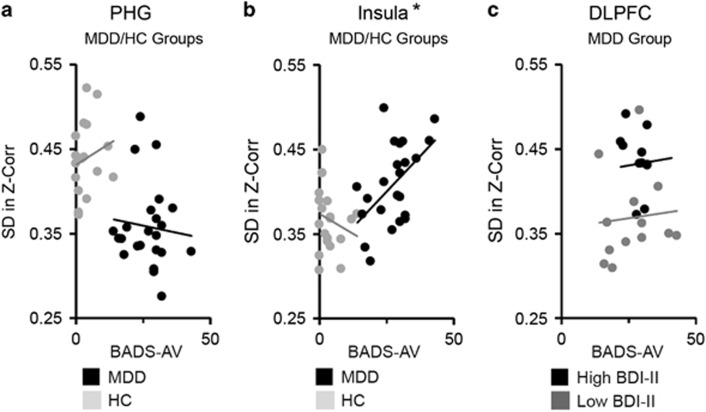Figure 3.
Rumination and dynamic resting-state functional connectivity of medial prefrontal cortex (MPFC). Multiple regression was used to investigate the relationship between rumination and dynamic resting-state functional connectivity between MPFC and regions implicated by the group contrast of participants with major depressive disorder (MDD) vs healthy control (HC) participants (parahippocampal gyrus (PHG) or insula), or regions implicated by depressive symptom severity as measured by the Beck Depression Inventory, Second Ed (BDI-II; dorsolateral prefrontal cortex (DLPFC)). Analyses were performed in a subset of the sample (n=45) who completed a self-report measure of recent rumination, the Behavioral Activation for Depression-Avoidance subscale (BADS-AV) at the Duke/UNC site. (a) Group (MDD coded as +1; HC coded as −1), recent rumination (mean-deviated BADS-AV), and the interaction between these factors were regressed on dynamic resting-state functional connectivity values (SD in Fisher's z-transformed Pearson's correlations across a series of sliding windows) extracted from PHG. No significant effects of rumination were detected. (b) Group, BADS-AV, and their interaction were regressed on dynamic functional connectivity values extracted from insula. Results showed a significant interaction between group and rumination, and follow-up simple regression analyses revealed that in the MDD group (but not the HC group), higher levels of recent rumination were associated with higher variability in MPFC-to-insula functional connectivity (*p<0.05). (c) Within the MDD group, BDI-II, BADS-AV, and their interaction, were regressed on dynamic functional connectivity values extracted from DLPFC. No significant effects of rumination were detected. Note: in panel c, the MDD group is median-split on BDI-II scores for display purposes, only. Analyses were performed using continuous measures.

